
La Banque du Peuple was a Canadian bank based in Montreal, active from 1835 to 1895.

La Banque du Peuple was a Canadian bank based in Montreal, active from 1835 to 1895.
The Banque du Peuple was founded in Montreal in 1835 by Jacob De Witt and the Louis-Michel Viger, initially under the name of Viger, DeWitt et Compagnie, operating as a private bank. [1] Viger was main proponent of the plan, while De Witt was a significant investor. [2] The initial capitalisation of the Banque was £75,000, a large portion coming from De Witt. [3] It was organized by French-Canadian and Scottish reformists who had hitherto been excluded by the English-dominated Tories who comprised the Bank of Montreal's board of directors. [4] It was granted a charter in 1844. [5]
The bank's clientele was predominantly French-speaking and it was a successful example of a French-speaking business in a financial world that was run almost exclusively by the English. In 1843, with the support of Louis-Michel Viger and other Montreal merchants who were keen to develop French-Canadian entrepreneurship, the bank adopted the name of Banque du peuple. It experienced strong growth from the end of the 1840s.
According to contemporaneous rumors, funds from La Banque du Peuple were used to finance the Lower Canada Rebellion in 1837. [6] At least one historian has suggested that the founding of the bank was designed to forestall rebellion, [7] and the means to peacefully advance the political and economic progress for French-Canadians. [8] Many of the prominent men involved in the founding and early operation of the bank took an active part in the rebellion, [9] and Viger was a cousin of the leader of the reformist Patriote movement, Louis-Joseph Papineau. [2] Another of Viger's cousins, Denis-Benjamin Viger, was also a major Patriote leader and was rumoured to have had an interest in the Banque, to advance the rebellion. [10] Thomas Storrow Brown, an early director of the bank who would go on to participate directly in the rebellion, resigned his position in the bank when external political events rebellion were coming to a head. It has been suggested that Brown was asked to resign so that the bank could disassociate itself from any suspicions as to where its political sympathies lay. [11]
The bank vigorously defended itself from these accusations, publishing a statement on behalf of its directors (referenced as "Deponents" below) in the Montreal Gazette on November 25, 1837 that included the following statement:
That the said Deponents perceiving that it has been falsely insinuated and spread in the public, that this Bank had lent or supplied funds for the purpose of purchasing arms, in order to destroy and subvert Her Majesty's Government in this Province, deem it their duty solemnly to affirm that such insinuations are wholly and altogether false and calumnious; the Deponents solemnly denying that this Bank ever did lend or supply any finds for that object, or for any criminal or illegal object whatsoever; and further the Deponents say not, and have signed. [12]
Regardless, many of prominent figures associated with the bank including Louis-Michel Viger, Denis-Benjamin Viger, Côme-Séraphin Cherrier, Édouard-Raymond Fabre, Joseph Roy, and John Donegani were all arrested after the rebellion, though significantly none of them were ever tried. [13]
In 1895, the bank suspended its activities and closed its doors shortly after its cashier J. S. Bousquet abruptly resigned, [14] and shortly afterward it was discovered that he made a large number of large, unsecured loans. [15] In total, the value of these credits was over CA$1,500,000 ($55.3 million in 2021 dollars). [16] Immediately after a public report came out in early 1896 with evidence that Bousquet was guilty of carrying out an unsafe lending policy, he fled to the United States with a large sum of money. [17] The directors of the bank also came under criticism for not properly overseeing the actions of the cashier and preventing what happened. [18] While the bank was able to improve its financial situation in the year after closing public operations, its directors were subject to unlimited liability, meaning that the directors were subject to any debts incurred by the bank, further reducing its ability to gain outside investment. [19] The bank managed to pay those who held the paper notes it issued in full, and in a compromise made to its creditors to release them from full liability, the bank's directors were able to repay 75% of the money owed to its depositors. [20] Following the bank's closure in 1895, several French-Canadian companies were drawn into its downfall. Long legal and political battles followed.
The Banque du Peuple building is located at 53–57, rue Saint-Jacques. ( 45°30′19″N73°33′26″W / 45.505414°N 73.5572119°W )
It was built in two stages. The original head office was built in 1871–72. Its facade was incorporated when the building was enlarged in 1893–94. It appears to the left of the current facade. The building is now occupied by a hotel, Le Place d'Armes.

This section of the Timeline of Quebec history concerns the events in British North America relating to what is the present day province of Quebec, Canada between the time of the Constitutional Act of 1791 and the Act of Union 1840.

Wolfred Nelson was the mayor of Montreal, Quebec, from 1854 to 1856.

The Bank of the People was created by radical Reform politicians James Lesslie, James Hervey Price, and Dr John Rolph in Toronto in 1835. It was founded after they failed to establish a "Provincial Loan Office" in which farmers could borrow small sums guaranteed by their land holdings. The Bank of the People was the only bank in Upper Canada not to suspend payments during the financial panic of 1837-8. Many of the shareholders, however, took part in the Rebellion of 1837 and the Family Compact plotted to have it taken over by the Bank of Montreal in 1840.
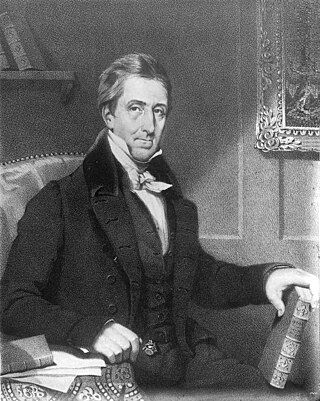
Denis-Benjamin Viger was a 19th-century politician, lawyer, and newspaper publisher in Lower Canada, who served as joint premier of the Province of Canada for over two years. A leader in the Patriote movement, he was a strong French-Canadian nationalist, but a social conservative in terms of the seigneurial system and the position of the Catholic church in Lower Canada.

Saint Denis Street is a major north–south thoroughfare in Montreal, Quebec.
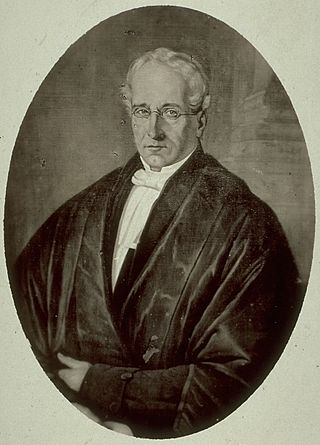
Austin Cuvillier was a businessman and political figure in Lower Canada and Canada East. He was a successful Canadien businessmen, unusual when most businessmen in Lower Canada were British. He also was a member of the Legislative Assembly of Lower Canada for twenty years, as a member for the Parti canadien, which tended to oppose the policies of the British-appointed governors. As a result, he served as a bridge between the conservative business community, and the more radical Parti canadien, although he finally broke with the Parti canadien prior to the Lower Canada Rebellion of 1837–1838.
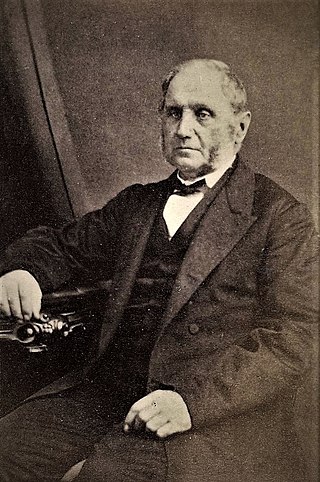
Pierre Beaubien was a physician and political figure in Canada East, Province of Canada. Trained in medicine in France, he practised and taught medicine in Montreal. He was involved in real estate development in Montreal, contributing to the creation of Outremont. He served two partial terms in the Legislative Assembly, the lower house of the Parliament of the Province of Canada, as a member of the French-Canadian Group under the leadership of Louis-Hippolyte LaFontaine.

Joseph-Édouard Turcotte was a lawyer, businessman, and political figure in Canada East. Born to a merchant family, he considered the priesthood, but after the loss of one arm in an accident, he opted instead for a legal career. In addition to the law, he was engaged in journalism and in business activities in Trois-Rivières.
Louis Lacoste was a notary and political figure in Lower Canada and then Canada East, Province of Canada. He was a member of the Legislative Assembly of Lower Canada, supporting Louis-Joseph Papineau and the Parti patriote. During the Lower Canada Rebellion he was imprisoned without trial, for his activities in the lead-up to the Rebellion. Following the creation of the Province of Canada, he was a member of the new Legislative Assembly for several years, and then a member of the Legislative Council. He was one of the original members of the Senate of Canada from 1867 to 1878.

Joseph-Guillaume Barthe was a lawyer, journalist, poet and political figure in Lower Canada and Canada East, Province of Canada. He served one term in the Legislative Assembly of the Province of Canada, as a supporter of Louis-Joseph Papineau and Denis-Benjamin Viger. He opposed Louis-Hippolyte LaFontaine's policy of building a reform alliance within the framework of the Province of Canada.
Thomas Boutillier was a doctor, Patriote, and politician in Lower Canada. Elected to the Legislative Assembly of Lower Canada in 1834, he was a member of the Parti patriote led by Louis-Joseph Papineau, which was challenging the British colonial government of the largely French-speaking province of Lower Canada. When the Lower Canada Rebellion broke out in 1837, he fought on the Patriote side in the Battle of Saint-Charles. Following the Patriotes' defeat, he fled to the United States. He returned to Lower Canada in 1838.
André Jobin was a notary and political figure in Lower Canada and Canada East.
Jacob De Witt was a businessman, banker and political figure in Lower Canada and Canada East, Province of Canada. Beginning in the hardware trade, he expanded into steamship transportation on the River St. Lawrence and then banking. He was elected to the Legislative Assembly of Lower Canada and generally supported the Parti patriote, but did not participate in the Lower Canada Rebellion of 1837. After the union of Lower Canada and Upper Canada into the Province of Canada, he was elected to the new Legislative Assembly. He initially supported the reform measures of Louis-Hippolyte LaFontaine, but gradually became more radical, ending his political career as member of the Parti rouge and calling for the voluntary annexation of Canada to the United States. He continued in business, particularly banking, until his death in 1859.

Louis-Michel Viger was a lawyer, banker, businessman, seigneur and political figure in Lower Canada, and then in Canada East in the Province of Canada.
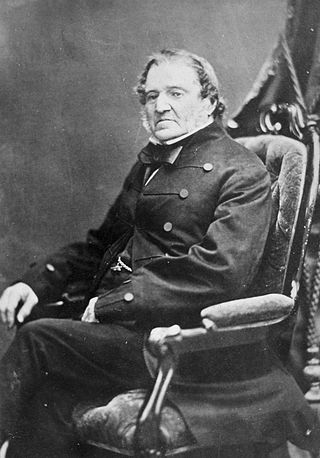
Frédéric-Auguste Quesnel,, was a lawyer, businessman and politician in Lower Canada. He was a member of the Legislative Assembly and the Executive Council of Lower Canada. Following the union of the Canadas, he was elected to the Legislative Assembly of the Province of Canada and later was appointed to the Legislative Council. Throughout his career he was a political moderate, seeking greater political power for French-Canadians under British rule, but also supporting the British connection generally. Condemned by the Patriotes as a vendu ("sell-out") in the Lower Canada Rebellion, in 1860 he was elected President of the Saint-Jean-Baptiste Society of Montreal.
René-Joseph Kimber was a physician and political figure in Lower Canada and Canada East, in the Province of Canada. He represented Trois-Rivières in the Legislative Assembly of Lower Canada, as a member of the Parti patriote, although he opposed the use of force in the Lower Canada Rebellion. After the creation of the Province of Canada, which he opposed, he was the member for the district of Champlain in the Legislative Assembly of the Province of Canada. He was briefly a member of the Legislative Council, prior to his death in 1843.
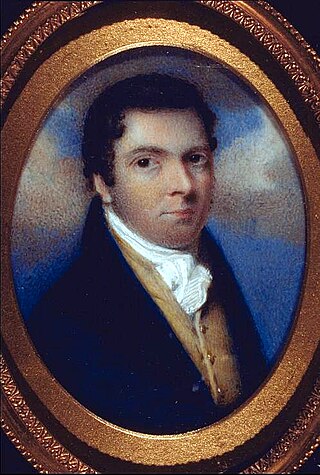
Côme-Séraphin Cherrier was a lawyer and political figure in Lower Canada.

Édouard-Raymond Fabre was a Canadian politician and bookseller, the Mayor of Montreal, Quebec between 1849 and 1851.
The following is an incomplete bibliography of the 1837-1838 insurrections in Lower Canada in the English and French languages, by publication date and document type.
Benjamin-Henri Le Moine was a banker and political figure in Canada East. He represented Huntingdon in the Legislative Assembly of the Province of Canada from 1844 to 1848.